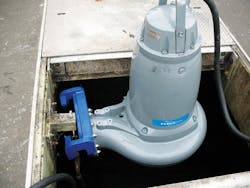Steve London is president of Steve London Associates. London can be reached at [email protected].
Located across the Columbia River from Portland, Ore., the city of Vancouver, Wash., has distinguished itself as a leader in effective sanitary sewer system management by maintaining adequate capacity, proactively maintaining sewage infrastructure and minimizing the cost for existing and new ratepayers.
The Vancouver area’s 201,000 residents are served by a wastewater collection system comprised of more than 660 miles of wastewater pipe and 35 pumping stations. The system interfaces with two wastewater treatment plants (WWTPs) with a total design flow of 37 million gal per day. The utility maintains smaller lift stations with direct city employees but contracts with Veolia Water North America for operation and maintenance of the two WWTPs and the city’s larger pump stations.
As with many municipal wastewater utilities elsewhere, some increasingly popular consumer products have proven problematic for elements of Vancouver’s infrastructure. Consider the millions of nonbiodegradable plastic water bottles that will be a lasting legacy in landfills. Volatile organic compounds left by leaking underground storage tanks are another environmental issue sometimes encountered during roadway improvements. For the workers that maintain the wastewater collection system of Vancouver, a particularly popular consumer product—household cleaning and personal wipes—emerged as a costly and paralyzing problem at a strategic lift station in 2004.
‘Disposable’ Does Not Mean ‘Flushable’
Built in 2000, the Andresen Pump Station is the largest lift station in the Vancouver system. The Andresen facility brought a 3,500-gal-per-minute (gpm) low-head facility online with a predominantly commercial and residential flow from a gravity line. The low-head station pumps the wastewater into an immediately adjacent high-head, 4,400-gpm pump station equipped with four 300-hp pumps. From there, the combined wastewater from another gravity facility and direct flow into the high-head station are pushed through a force main over a hill with a 130-ft elevation before advancing to one of the WWTPs.
“When the pump station came online just before 2004, we noted routine maintenance incidents involving clogged pumps. As the years passed, the clogging and maintenance increased to a frequency of twice and sometimes three times per week,” said Frank Dick, P.E., an engineer with Vancouver’s Public Works. “It became apparent there was a direct correlation between household cleaning and personal wipes and the ragging that steadily sapped the flow and efficiency of the pumps. The increased incidences of clogging at the low-head lift station averaged three unscheduled maintenance dispatches a week. To clear the entangled impeller of a 40-hp pump at the low-head facility normally took two hours by an outsourced crew at a rate of $80 per hour. The unscheduled maintenance was becoming cost-prohibitive, further aggravated by excessive electricity usage as the ragging progressively reduced the rpms of the former pump motors, thereby increasing their power draw and reducing efficiency.”
Household cleaning and personal wipes began to rival the clogging problem presented earlier by disposable diapers, a problem addressed in a utility study and public information campaign.
Pump Power
The city’s engineering staff contacted Whitney Equipment Co. in October 2008 following a favorable experience using Flygt pumps to prevent recurring clogging at a similarly sized lift station. Whitney Equipment had recommended an “N pump” developed by ITT Water & Wastewater to replace that earlier station’s existing units, and proposed the same pump to prevent clogging in the low-head Andresen station.
In field tests where recurring blockages were an issue in wastewater collection utilities, the pumps not only eliminated clogging but also delivered significant power savings that would accrue throughout the expected service life period of more than 50 years. The reliability of an N pump can be attributed to the semi-open, screw-shaped impeller that prevents clogging and facilitates the unobstructed flow of fibrous material. Without material wrapping around the impeller and sapping pump flow and efficiency, energy savings often exceeded 45% during field tests due to the patented component.
The leading edge of the pump’s rotating impeller passes across a stationary relief groove located in the pump suction port. The dynamic action cleans and pumps away any rags, stringy materials and solids from the impeller without compromising the hydraulic efficiency. The engineering is more reliable than traditional chopper pumps that can grind rags and other debris but are less effective against hard foreign materials.
Trial Data Pays Off
Frank Dick was aware of an energy conservation program spearheaded by Bonneville Power Administration (BPA) that would pay a portion of energy-efficient retrofits in the form of incentive rebates. Similar and often overlooked programs exist elsewhere across the nation through other electric utilities.
BPA launched the Energy Smart Industrial (ESI) program to assist BPA utility providers, including Clark Public Utilities (CPU) and industrial facility customers committed to increasing cost-effective energy-efficiency initiatives. The program is a primary mechanism whereby utility customers supplied by CPU can achieve industrial load reduction. The industrial sector typically includes a broad range of manufacturers and, in particular, their fixed pieces of equipment, buildings or complexes used in connection with a process or system.
Dick pointed out that Vancouver’s wastewater system potentially was eligible for a direct incentive payment to underwrite a portion of the pump station retrofit cost if the utility could demonstrate energy savings from the operation of the replacement pumps. He submitted a simple project application to CPU, which was approved for rebate based on measured energy savings.
Armed with foresight, ESI installed a meter to measure the energy usage of both of the low-head station’s 25-hp replacement N pumps. Although 15 hp smaller than the original 40-hp pump they replaced, the new pumps had operated flawlessly at preventing clogs and used 45% less energy during a trial period.
The findings were compiled by ESI engineers, then submitted to BPA and the local utility. The retrofit resulted in a rebate check for $19,000.
Dick had little problem convincing the city’s public works management to approve the expenditure for the cost to replace the original pumps. He presented an electricity cost savings analysis and a 2-in.-thick file of work orders for unscheduled maintenance at the low-head station, he said. Each page represented a $160 expenditure.
By eliminating unscheduled maintenance, the utility stood to save at least $20,000 annually by replacing the original pumps with the new pump units. Electric utility reductions will add to the total savings over the life of the equipment.
For more than a year before receiving their routine maintenance inspections, the two low-head 25-hp Flygt units continued to run without ragging and never exceeded a 32-amp draw, according to SCADA reports. The only problem occurred from ragging passing through the low-head station’s pumps and increasing the fibrous loading in the high-head station.
The 300-hp/4,400-gpm pumps in the high-head station since have become candidates for replacement with N-type units in 2011. ITT Water & Wastewater has guaranteed that the 300-hp N pumps will deliver at least a 25% energy savings compared to the former units.
Article Summary
Challenge: Routine maintenance incidents involving clogged pumps increased in frequency so much that Vancouver, Wash., sought a solution to prevent recurring clogging.
Solution: On a recommendation, the city installed a new pump featuring a semi-open, screw-shaped impeller that prevents clogging and facilitates unobstructed flow.
Conclusion: The utility saw a total savings of more $20,000 annually when accounting for both energy savings and its elimination of unscheduled maintenance.
Download: Here



